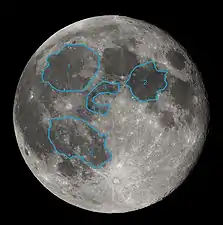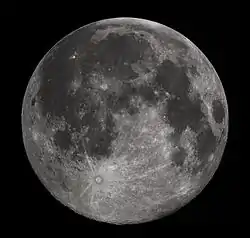Man in the Moon
The Man in the Moon refers to any of several pareidolic images of a human face, head or body that certain traditions recognize in the disc of the full moon. The images are composed of the dark areas of the lunar maria, or "seas" and the lighter highlands of the lunar surface.

Origin

There are various explanations for how the Man in the Moon came to be.
A longstanding European tradition holds that the man was banished to the Moon for some crime. Christian lore commonly held that he is the man caught gathering sticks on the Sabbath and sentenced by God to death by stoning in the book of Numbers XV.32–36.[1] Some Germanic cultures thought he was a woodcutter found working on the Sabbath.[2] There is a Roman legend that he is a sheep-thief.
One medieval Christian tradition claims him to be Cain, the Wanderer, forever doomed to circle the Earth. Dante's Inferno[3] alludes to this:
For now doth Cain with fork of thorns confine
On either hemisphere, touching the wave
Beneath the towers of Seville. Yesternight
The moon was round.

This is mentioned again in his Paradise:[4]
But tell, I pray thee, whence the gloomy spots
Upon this body, which below on earth
Give rise to talk of Cain in fabling quaint?
There is also a Mediaeval Jewish tradition that the image of Jacob is engraved on the Moon.[5][6][7]
John Lyly says in the prologue to his Endymion (1591), "There liveth none under the sunne, that knows what to make of the man in the moone."[8]
In Norse mythology, Máni is the male personification of the Moon who crosses the sky in a horse-drawn carriage. He is continually pursued by the Great Wolf Hati who catches him at Ragnarök. Máni simply means "Moon".
In Chinese mythology, the goddess Chang'e is stranded upon the Moon after foolishly consuming a double dose of an immortality potion. In some versions of the myth, she is accompanied by Yu Tu, a Moon rabbit.[9]
In Haida mythology, the figure represents a boy gathering sticks. The boy's father had told him the Moon's light would brighten the night, allowing the chore to be completed. Not wanting to gather sticks, the boy complained and ridiculed the Moon. As punishment for his disrespect, the boy was taken from Earth and trapped on the Moon.[10][11]
In Japanese mythology, it is said that a tribe of human-like spiritual beings live on the Moon. This is especially explored in The Tale of the Bamboo Cutter.
In Vietnamese mythology, the Man in the Moon is named Cuội. He was originally a woodcutter on Earth who owned a magical banyan. One day, when his wife ignorantly watered the tree with unclean water and caused it to uproot itself to fly away, Cuội grabbed its roots and was taken to the Moon. There, he eternally accompanied the Moon Lady and the Jade Rabbit.[12][13] The trio has become the personifications of the Mid-Autumn Festival, when they descend to the mortal world and give out cellophane lanterns, mooncakes and gifts to children.[14]
Traditions
There is a traditional European belief that the Man in the Moon enjoyed drinking, especially claret. An old ballad runs (original spelling):
Our man in the moon drinks clarret,
With powder-beef, turnep, and carret.
If he doth so, why should not you
Drink until the sky looks blew?[15]
In the English Middle Ages and renaissance, the Moon was held to be the god of drunkards, and at least three London taverns were named "The Man in the Moone".[16] The man in the Moon is named in an early dated English nursery rhyme:
The man in the moon came tumbling down
And asked his way to Norwich;
He went by the south and burnt his mouth
With supping cold pease porridge.
Examples and occurrence globally
One tradition sees a figure of a man carrying a wide burden on his back. He is sometimes seen as accompanied by a small dog.[17] Various cultures recognise other examples of lunar pareidolia, such as the Moon rabbit.[18]
In the Northern Hemisphere, a common Western perception of the face has it that the figure's eyes are Mare Imbrium and Mare Serenitatis, its nose is Sinus Aestuum, and its open mouth is Mare Nubium and Mare Cognitum.[19] This particular human face can also be seen in tropical regions on both sides of the equator. However, the Moon orientation associated with the face is observed less frequently—and eventually not at all—as one moves toward the South Pole.
Conventionalized illustrations of the Man in the Moon seen in Western art often show a very simple face in the full moon, or a human profile in the crescent moon, corresponding to no actual markings. Some depict a man with a face turned away from the viewer on the ground, for example when viewed from North America, with Jesus Christ's crown shown as the lighter ring around Mare Imbrium. Another common one is a cowled Death's head looking down at Earth, with the black lava rock 'hood' around the white dust bone of the skull, and also forming the eye sockets.
"The Man in the Moon" can also refer to a mythological character said to live on or in the Moon, but who is not necessarily represented by the markings on the face of the Moon. An example is Yue-Laou, from Chinese tradition;[20] another is Aiken Drum from Scotland.
The Man in the Moone by Francis Godwin, published in 1638, is one of the earliest novels thought of as containing several traits prototypical of science fiction.
Scientific explanation
The Man in the Moon is made up of various lunar maria (which ones depend on the pareidolic image seen). These vast, flat spots on the Moon are called "maria" or "seas" because, for a long time, astronomers believed they were large bodies of water. They are large areas formed by lava that covered up old craters and then cooled, becoming smooth, basalt rock.[21]
The near side of the Moon, containing these maria that make up the man, is always facing Earth. This is due to a tidal locking or synchronous orbit. Thought to have occurred because of the gravitational forces partially caused by the Moon's oblong shape, its rotation has slowed to the point where it rotates exactly once on each trip around the Earth. This causes the near side of the Moon to always turn its face toward Earth.[22]
Gallery
 Near full moon over Berlin, Germany, in December 2015, approximately 30 minutes after moonrise
Near full moon over Berlin, Germany, in December 2015, approximately 30 minutes after moonrise Common interpretation of the Man in the Moon as seen from the Northern Hemisphere
Common interpretation of the Man in the Moon as seen from the Northern Hemisphere Modeled appearance for same longitude 30 minutes after moonrise
Modeled appearance for same longitude 30 minutes after moonrise
References
- Harley, the Rev. Timothy, FRAS (1885). Moon Lore, London; Swan Sonnenschein, Le Bas & Lowry. p. 21. Archived at Internet Sacred Text Archive. Retrieved March 2, 2014.
- Baring-Gould, Sabine. "The Man in the Moon", Curious Myths of the Middle Ages, London. Rivington's, 1877, p. 190
 This article incorporates text from this source, which is in the public domain.
This article incorporates text from this source, which is in the public domain. - Dante, The Divine Comedy, Inferno, canto 20, line 126 and 127. The Dante Dartmouth Project contains the original text and centuries of commentary.
- Dante, The Divine Comedy, Paradiso, canto 2, line 51.
- Wolfson, Elliot R. "The Face of Jacob in the Moon" in The Seductiveness of Jewish Myth: Challenge or Response? edited by S. Daniel Breslauer, Albany NY; SUNY Press, 1997
- Harley, the Rev. Timothy, FRAS (1885). Moon Lore, London; Swan Sonnenschein, Le Bas & Lowry. p. 21
- Harley, Timothy (1885). "II. The Man in the Moon." Internet Sacred Text Archive. Retrieved March 2, 2014.
- Child, Clarence Griffin (1894). John Lyly and Euphuism. Erlangen [etc.]: A. Deichert. p. 118. OCLC 1014813258.
- Xueting Christine Ni (2018). From Kuan Yin to Chairman Mao: The Essential Guide to Chinese Deities. Red Wheel/Weiser. pp. 40–43. ISBN 1578636256.
- (1899). Report of the 68th Meeting of the British Association for the Advancement of Science 1898. 1899. London: Murray. p. 704.
- The Hydah mission, Queen Charlotte's Islands Archived 2012-10-20 at the Wayback Machine Charles Harrison, Church Missionary Society c. 1884
- Chú Cuội or The Man in the Moon
- Vietnam's magical Mid-autumn Festival
- Fairy Tale of Moon Lady in Vietnam
- The Man in the Moon drinks Claret, as it was sung at the Court in Holy-well. Bagford Ballads, Folio Collection in the British Museum, vol. ii. No. 119.
- Poole, William (2009), "Introduction", in Poole, William (ed.), The Man in the Moone, Broadview, pp. 13–62, ISBN 978-1-55111-896-3
- Evans, Ben (2010). Foothold in the Heavens: The Seventies. Springer Science & Business Media. p. 143. ISBN 1441963421.
- Windling, Terri. "The Symbolism of Rabbits and Hares" Retrieved September 1, 2018.
- Skilling, Tom (January 20, 2017). "Ask Tom: What creates the 'man in the moon'? ". Chicago Tribune. Retrieved September 1, 2018.
- Xueting Christine Ni (2018). From Kuan Yin to Chairman Mao: The Essential Guide to Chinese Deities. Red Wheel/Weiser. p. 141. ISBN 1578636256.
- Harrington, Philip S., and Edward Pascuzzi (1994). Astronomy for All Ages: Discovering the Universe through Activities for Children and Adults. Old Saybrook, CT: Globe Pequot.
- "Looking at the Man in the Moon". www.caltech.edu. California Institute of Technology. Archived from the original on August 8, 2014. Retrieved July 31, 2014.

